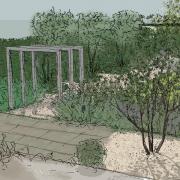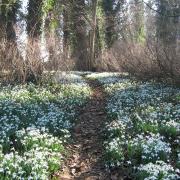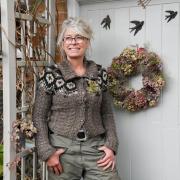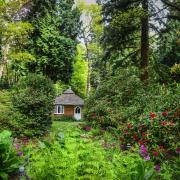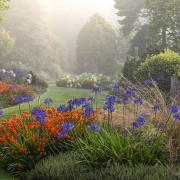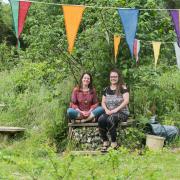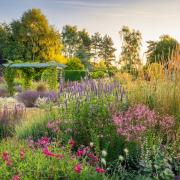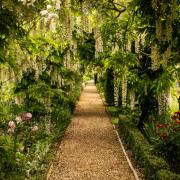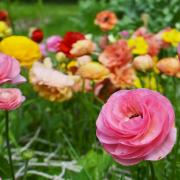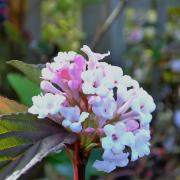As the days lengthen, it’s time once again to venture out and about, into some of Norfolk’s best gardens. Where better to start than the spring display at Hindringham Hall?

Wordsworth’s famous poem is thought to be one of the most widely read in the English language. Perhaps this reflects our relief and pleasure at the appearance of those “hosts of golden daffodils” after the bleak winter months, reassuring us that spring really has arrived and looking forward to warmer, sunnier times (in theory). At Hindringham Hall, in north Norfolk, the springtime celebration is spectacular, with more than 30 different varieties of Narcissus carpeting the banks of the 12th century moat, from sturdy trumpeters to graceful creamy-white jonquils.

While these are the obvious show-stoppers, they are not by any means the only players. The support act includes frothy forsythia, statuesque flower spikes of elephants’ ears (Bergenia cordifolia) and long-lasting hellebores in shades of marbled pink and purple. Drumstick primulas are in evidence in the stream garden and under a young weeping willow the sunny yellow of marsh marigolds (Caltha palustris) creates a golden glow. This diversity of planting attests to the range of growing environments here at Hindringham.

“We have huge variation in habitat for the plants,” confirms owner Lynda Tucker, “from shade to open sun, free-draining to boggy. The candelabra primulas like the clay, and there’s a lot of that about as the moat’s lined with clay.”

The moat is thought to date from around 1150, and surrounds a fine Tudor house which was built with stone and flint acquired from monasteries dissolved by Henry VIII. To the south of the moat are a series of ponds which originally produced fish for the Prior of Norwich in medieval times. Lynda and husband Charles have recently acquired these fishponds and Charles’ current project is their restoration, clearing a jungle of vegetation and reintroducing the concept of “pond” to the marshy morass. “It was mainly about discovering how the whole thing worked and then putting a dam in the right place,” he explains modestly.

The moat, together with the stream and ponds, is a Scheduled Ancient Monument, and the house is Grade II Star listed, but the grandeur of these designations belies the down-to-earth approach of the couple when it comes to the garden. While others may populate their plots with fully grown shrubs and multiple perennials of the same variety for instant effect, Lynda is a firm believer in the power of propagation and patience: “I enjoy making a silk purse out of a sow’s ear, I suppose,” she says. “You’ve got to have time in a garden, I think - a five-year idea. You can buy something large and put it in, but it won’t do as well as if you buy something smaller and wait for it to grow.”

While she’s waiting, Lynda fills in the gaps with annuals, including scented tobacco plant (Nicotiana sylvestris). She grows these, and all the vegetables for the kitchen garden, from seed, recycling plastic knives as greenhouse plant labels, and toilet rolls as bio-degradable plant pots to give her sweet peas and runner beans a good deep root run in which to start their short lives.

Lynda has encouraged the hundreds of daffodil bulbs to increase in number over the years, with selective feeding from homemade compost, spread during the summer months. She also lifts and divides overcrowded clumps, replanting where’s there’s a gap, although this can prove problematic. “Once they’ve died down you haven’t a clue what’s there,” she explains with a smile. “So that is where a camera is so good; I take photos of the gaps in the spring, and then, provided I can recognise a neighbouring tree, it shows us where to replant the bulbs in August and September.”

She has, however, thankfully abandoned dead-heading: “I used to get the grandchildren to help me, but the thinking now is that you don’t have to (dead-head) as long as you let them die down without disturbance.”

Since Charles and Lynda moved here in 1993, they have nurtured and extended the gardens, reclaiming herbaceous borders that had been grassed over, as well as developing new areas for a succession of planting which lasts from spring right through until autumn. This enthusiasm for enlarging the garden has not been universally welcomed: “I had one gardener in to help me at one point, and he put stakes in the water garden so I wouldn’t garden any further out,” she laughs. “Needless to say, we have gone beyond those now.”
Her passion for gardening through the seasons has been accompanied by the opening of the gardens to the public on a regular basis, although at first Lynda was reluctant. “It had always been ‘just our garden’,” she explains, “but the National Garden Scheme asked if we’d open and I was talked into it. I’m really happy now with that decision because it’s so nice to share it. Fellow gardeners in particular understand the work that has gone into it, and a lady said to me the other day: ‘I think I’ve died and gone to heaven’.” In the idyllic setting of this moated manor house with its carpets of glowing daffodils you can see why. Wordsworth would have been very happy here.
Opening TIMES:
Hindringham Hall is open for the National Garden Scheme on Sunday, April 3 from 10am to 4pm, admission £5 and children free.
From April until the end of September, the gardens are open on Wednesdays 10am to 1pm and Sundays 2-5pm, admission £7 and under 15s free.
Hindringham Hall is seven miles from Holt, Fakenham and Wells. Turn off the A148 at the Crawfish pub, drive two miles to Hindringham and turn left into Blacksmiths Lane; 01328 878226; www.hindringhamhall.org




